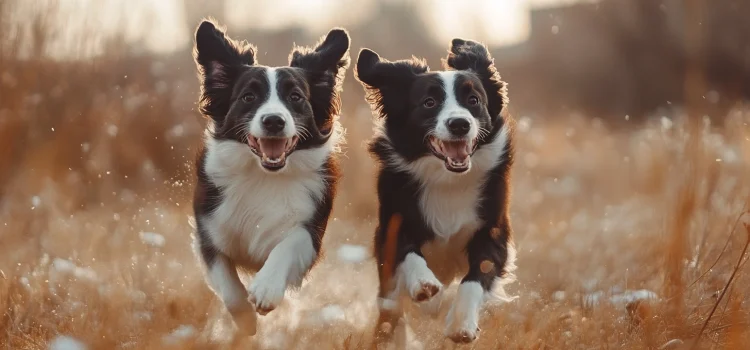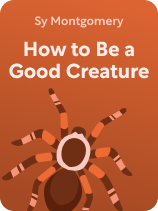

This article is an excerpt from the Shortform book guide to "How to Be a Good Creature" by Sy Montgomery. Shortform has the world's best summaries and analyses of books you should be reading.
Like this article? Sign up for a free trial here.
Why are border collies the best dogs? Why is it so hard to get a new pet after another passes away?
In their many years at the farmhouse, Sy Montgomery and her husband Howard rescued several border collies. She looks back on the lessons about love that Montgomery learned from two of them: Tess and Sally.
Here’s how two of Montgomery’s border collies ended up changing her life.
1. Sy Montgomery’s Border Collie Named Tess
According to Montgomery, her first border collie Tess taught her lessons about how to trust others, be resilient, and love life even when your circumstances change, showing why border collies are the best dogs. Montgomery and her husband got Tess from a rescue when she was two years old. By that point, Tess already had a difficult past, but she was a loving and active dog.
(Shortform note: Rescue dogs can bring a wealth of love and joy into your life, but like Tess, many of them come from difficult backgrounds. To help a rescue dog adjust to life in your home, consider the following tips: First, practice patience as much as possible. Dogs who’ve had bad experiences with people in the past may take longer to settle down and trust you. Additionally, keep their routine as consistent as possible to help them feel secure. If you can, feed them, walk them, and play with them at the same times every day so they learn what to expect from you.)
Tess loved to chase frisbees in the field surrounding Montgomery’s home. Montgomery particularly enjoyed playing frisbee with her at night—Montgomery would throw the frisbee blindly in the dark, and Tess would always find it with her canine night vision and bring it back. Tess guided Montgomery patiently through the dark, and they developed a bond of love and trust through this ritual.
(Shortform note: Developing a similar ritual of play with your dog can help you create a bond as close as the one Montgomery had with Tess. Beyond the beneficial mental stimulation and exercise that play offers your dog, it also prompts the release of the neurochemical oxytocin in both humans and dogs. Oxytocin encourages emotional connection and social bonds, so playing with your dog helps increase your feelings of love toward each other.)
As Tess got older, she lost her hearing and began to lose her vision, which meant she could no longer play frisbee as she had in the past. At first, Montgomery despaired over Tess’s new limitations, terrified of her dog’s mortality. However, she soon realized that Tess seemed to love her life just as much as she had before. Tess was content to switch roles with Montgomery on their nightly outings, allowing Montgomery to lead her around on walks in the dark.
(Shortform note: Many dogs will experience some vision loss, hearing loss, and mobility issues as they age, so you may need to find new ways to keep them active and engaged, as Montgomery did with Tess. Short, frequent walks can keep them at a healthy weight and help them stay mobile. Additionally, you can introduce new toys like puzzle feeders that keep them entertained without straining them too much physically.)
Tess’s contentment just to be around the people she loved showed Montgomery how to appreciate the simple joys of life. (Shortform note: Research suggests that focusing on gratitude for the positive things in your life during challenging times—as Montgomery demonstrated—can greatly improve your mental health. Some studies found that just one instance of experiencing gratitude reduced depression symptoms by up to 35% and increased feelings of happiness by up to 10%. Regularly practicing gratitude can also help prevent mental health struggles such as anxiety and depression when you’re experiencing difficult circumstances.)
Additionally, the trust and affection Tess showed on their nighttime walks was a type of love Montgomery had never experienced before. Tess trusted her enough to entirely depend on her, and the collie’s strength of spirit through all her difficulties moved Montgomery deeply.
(Shortform note: As Montgomery experienced, the bond you have with your pet can strengthen your mental health. Caring for your pet and building trust with them can create feelings of fulfillment and purpose. Their unconditional love can also improve your self-esteem—pets can respond to your emotions, offer comfort, and reduce feelings of loneliness.)
2. Sy Montgomery’s Second Border Collie, Sally
Sally was the second border collie Montgomery and Howard rescued. She was different from Tess in almost every way, but Montgomery still loved her—proving there’s no limit to the amount of love we can offer.
After Tess and Christopher (Montgomery’s pet pig) passed away, Montgomery went through a period of intense grief and depression. She couldn’t picture a future without them in her life, and she wasn’t ready to think about adopting another dog.
(Shortform note: Deciding when to get a new dog after your previous dog passes away can be difficult. Some experts say that it’s important for you to process your grief before adopting another dog. If you’re having a difficult time, a licensed counselor can help you work through the loss. It’s also important to consider the needs of any other pets you have before introducing a new dog. Think about whether a new dog will disrupt their lives even more, or if they could use a companion after losing their old friend.)
Montgomery’s reluctance to adopt another dog changed when she had a dream where Tess appeared to her and then transformed into a different border collie. Montgomery saw that as a sign that it was time to get a new dog, and she set out to find the collie from her dream. After a long search, she and her husband found a border collie at the same rescue they’d adopted Tess from. To Montgomery, it felt like fate, and she was certain that this was the dog from her dream.
(Shortform note: Some research suggests that dreams play an important role in the grieving process. One study revealed that people who dreamed of their lost loved ones found the dreams healing and were better able to accept death. A common type of grief dream is message dreams, which happen when a deceased loved one shows up in a dream to pass on information or show us something important. Montgomery’s dream of Tess falls into this category.)
They named the dog Sally, and she proved to be opposite from Tess in almost every way—she didn’t like to play fetch, and she loved to get into mischief and steal household items. Unlike Tess, who’d been more interested in playing than cuddling, Sally loved affection. Despite these differences, Montgomery loved Sally just as much as she loved Tess. In her unique way, Sally filled the hole that Tess had left, and she proved to Montgomery that her love had no limits—it only expanded to fit Sally.
(Shortform note: When you get a new dog, it’s natural to compare them with your previous pet. This can make it harder to bond with the new dog. If this is your experience, some experts suggest finding a moment to spend time with your new dog and tell them about your old dog. Even if it feels silly, it can be cathartic to tell them stories about your old dog that make you laugh and cry, and doing so brings your new dog into those memories. By sharing these experiences and emotions, you can begin to release them and make new memories with your new dog.)

———End of Preview———
Like what you just read? Read the rest of the world's best book summary and analysis of Sy Montgomery's "How to Be a Good Creature" at Shortform.
Here's what you'll find in our full How to Be a Good Creature summary:
- Lessons about life and love that naturalist Sy Montgomery learned from animals
- How to appreciate animals and people in new ways
- How to be more curious, compassionate, friendly, and loving






